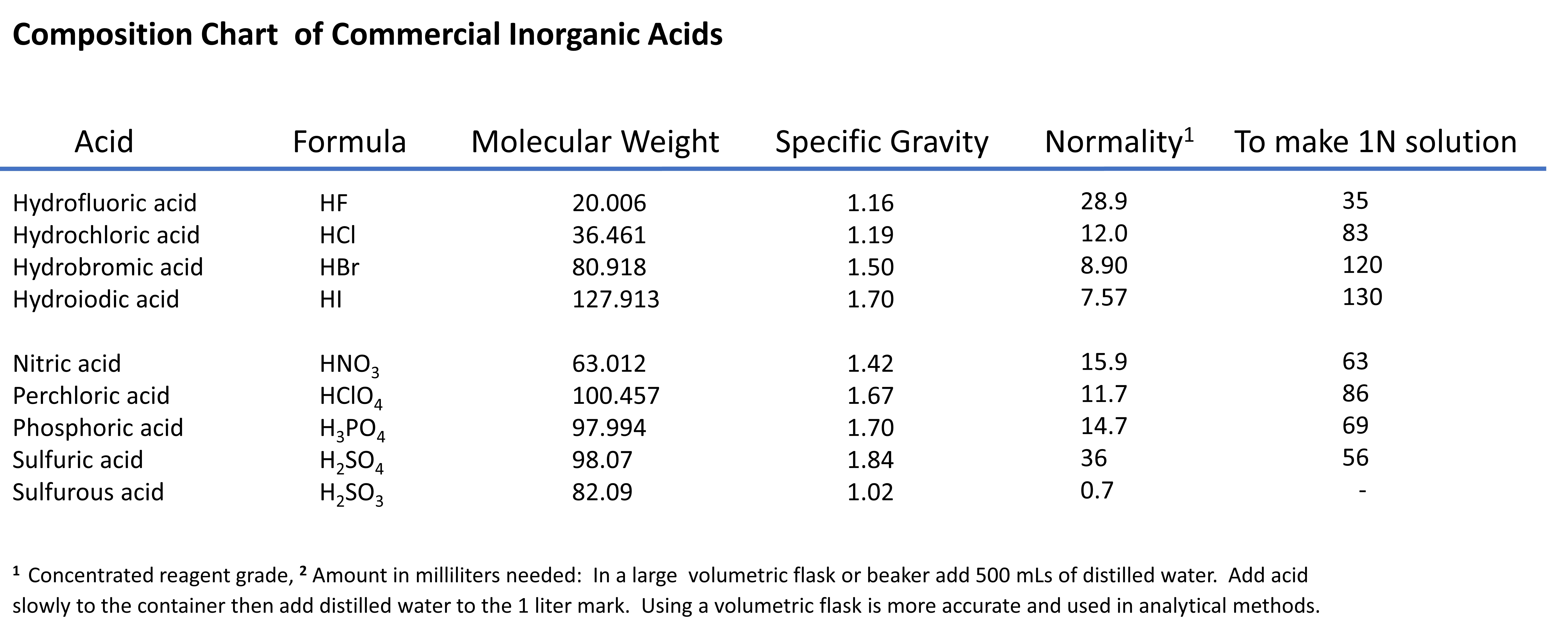Working with Inorganic Acids in the Laboratory: A Practical Guide
Working with Inorganic Acids in the Laboratory
Acids are of great importance in the laboratory and are used in all areas of chemical and pharmaceutical manufacturing as well as in analytical chemistry. Inorganic acids are broken down into 2 main groups the hydracids, which lack oxygen such as hydriodic, hydrobromic, hydrochloric, and hydrofluoric acids, with anions representing the 2nd to 5th periods of Group VIIA in the Periodic Table, and oxygen-containing acids, such as phosphoric acid, nitric acid, and sulfuric acid.
Laboratory inorganic acids such as sulfuric acid and hydrochloric acid are used routinely, while the others are typically encountered in organic synthesis laboratories, or have special uses in commerce, where hydrogen fluoride, HF, is used to make refrigerants, drugs, agrochemicals, petrochemicals and plastics among others, and is extremely toxic and can kill you. It should be used only by highly trained chemical personnel.

Percentage Strengths
Inorganic acids are made commercially available as concentrated aqueous solutions, and the percent strength varies between acids, where reagent grade hydrochloric acid varies between 36.6 to 38% of HCl, and nitric acid can vary between 69 to 71% by weight.
To calculate the absolute amount of acid in 100 mL of a solution, the following equation is used:
M=V x S x F
where M is the mass in grams, V is the volume in mL of the solution, S is the specific gravity of the acid (grams per milliliter) and F is fractional strength of the acid.
For example, Sulfuric Acid is 96% in concentrated form and described on the bottle, to find the amount in grams (M) in 100 mL, use the chart above to find the specific gravity.
M= 100 x 1.84 x 0.96 = 176.6 grams in 100 milliters
Acid Handling Safety
When diluting a concentrated acid with water ALWAYS ADD ACID TO WATER-ALWAYS! Failure to do so may cause an exothermic reaction with chemical splattering, explosion, and may cause serious bodily harm and death.
Inorganic acids are caustic and corrosive, and are damaging to biological molecules, skin and mucous membranes, targeting the eyes, and pose a health hazard to those exposed by vapors or direct contact with the liquids themselves.
Proper personal protection must be used when handling inorganic acids and safety goggles, lab coats, and gloves resistant to acids are mandatory.
For hydrochloric acid, HCl, latex, nitrile, or vinyl disposable gloves can be used.
For sulfuric acid, H2SO4, latex or vinyl gloves should be used.
For further information and safety data on Inorganic Acids please consult:
The NIOSH Pocket Guide to Chemical Hazards
Chemical Incompatibilities and Uses in the Laboratory
- Acids mixed with carbonates give off carbon dioxide, and must be handled in a hood to avoid an asphyxiation hazard.
- Acids mixed with carbonates give off carbon dioxide, and can generate dangerous pressures in closed containers.
- Acids mixed with nitrogen containing compounds are used to make water soluble compounds as hydrochloride salts, sulfuric acid salts, and others used in medicine and commerce.
- Plastics, polymers and metals all have different resistances to different acids. Please see our Chemical Resistance Information Page and Charts on our website.
- Please contact us anytime for more Technical Information and for a prompt response, at Ask A Chemist.
Recent Posts
-
Disinfecting Surfaces in the Era of Covid and EPA Registered Commercial Disinfectants and Viricides
The disinfection of surfaces at home, in public spaces, and in hospitals and clinics needs to be a …15th Jan 2023 -
Working with Inorganic Acids in the Laboratory: A Practical Guide
Working with Inorganic Acids in the LaboratoryAcids are of great importance in the laboratory and ar …4th Jan 2023 -
The Top 12 Drinking Water Contaminants
1.Lead- from older plumbing systems pre-1986, when lead pipes, solder, and components were banned. …14th Dec 2022
